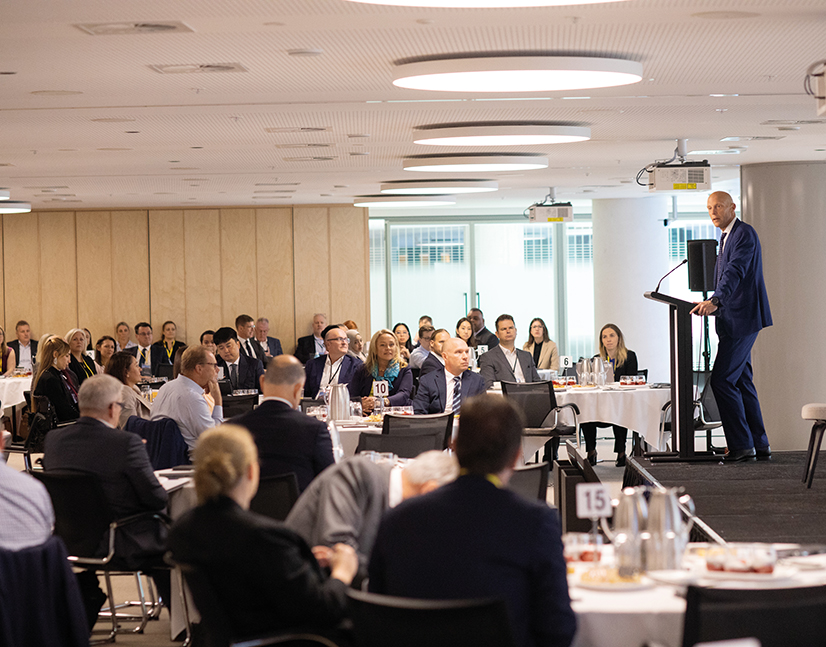
Conditions align for government issuers within Australia
A set of circumstances conducive to borrowing has characterised the Australian government sector in the last 12 months. A lower sovereign requirement, regulatory changes and benign market conditions have all provided tailwinds, even as the economy has slowed. KangaNews convened the sector’s largest issuers in Sydney in January to discuss the state of play.

DEMAND CONDITIONS
Zaunmayr Liquidity and cost of funds have been favourable in the last 12 months. But has the falling Australian cash rate made it harder to find demand diversity – especially offshore?
In the last 18 months, one of the big things we have been following is the increase in Japanese capital allocated into the US and euro markets. This became evident when we went to Tokyo in November 2019. We have soft demand in our 20-year stocks. However, it does not seem to have affected the 2047.
This is still the maturity sweet spot and where we are receiving much demand, particularly from offshore. We have seen a pickup from Japan in the last few weeks. Demand was quite slow at the end of last year but we are now seeing more interest, domestically and offshore.
In 2019, we saw a deterioration of the global economy, driven largely by trade-related issues. This made markets challenging at times but there were also many tailwinds for the semi-government sector, such as spreads and the reduced AOFM [Australian Office of Financial Management] task, giving investors some comfort on the supply coming from the sector.
The clear evidence for me was that ourselves and TCorp were both successfully in the market, for a total of more than A$5 billion [US$3.4 billion], shortly after the release of our new borrowing programmes.
I agree with Rob Nicholl about offshore investors, in the sense that the Australia-US spread is not the only focus for some of them. In fact, offshore investors have driven a substantial amount of the reverse-enquiry issuance we have done in the 10-year part of the curve.
"We didn't see much change in behaviour from investors in our syndicated transactions or turnover data through 2019. But the committed liquidity facility changes have a long phase-in period and we think they will continue to offset increased supply over the next five years."
These investors were looking for yield and exposure to Australian dollars. Our transaction was timely in that supranational, sovereign and agency borrowers haven’t issued as much in the Kangaroo market as they typically would at this time of year. We probably took some of that demand.
The currency has stabilised now, so it will be interesting to see how offshore demand evolves. It looks as though the yield curve differentials are starting to hold up and investor interest has come back – as we saw with the TCV [Treasury Corporation of Victoria] deal in January.
Some investors said they were struggling to allocate if they did not have long-term access to repo facilities. These pressures seem to have eased in the last 6-8 months, though.
Unprecedented Disaster, Limited Impact
Catastrophic flooding, drought and bushfires ravaged Australia during 2019 and early 2020. State and sovereign borrowers outline the mechanisms that come into play to ensure funding requirements do not blow out as a result.
NICHOLL Investors have asked about the impact of the recent bushfires. A couple of years ago, when there were large floods and cyclones in Queensland, the effect on GDP was about 0.6 per cent. This is large but it includes factors such as mine closures and other business interruptions. These events are complex and unique so it is difficult to make generalisations on outcomes.
TRIGONA New South Wales (NSW) has been one of the worst-affected states and we are still very much in the assessment phase. There are a few disaster funding arrangements. One is the disaster-relief funding aspect of the Commonwealth and state cost-sharing arrangement. This was announced with the prime minister’s A$2 billion (US$1.4 billion) relief package. All the states that need it will benefit from this.
Zaunmayr How much have the changes to Australia’s committed liquidity facility (CLF) affected domestic demand for semi-government paper? Has this helped mitigate concerns about the sector’s higher aggregate requirement?
Investor focus has moved instead to relative value and, as Jose Fajardo says, semis’ spread relative to the Commonwealth has been the main driver of increased interest from real-money managers as yields have fallen.
This said, we did not see much change in behaviour from investors in our syndicated transactions or turnover data through 2019.
But the CLF changes have a long phase-in period and we think they will continue to offset the increased level of supply over the next five years.
We have had interest in our 2034 from several major-bank balance sheets so there is potential for further migration out on the curve into liquid lines. This is a positive for all of us.
SUPPLY PROFILE
Zaunmayr The issuance trend is for less primary supply from the AOFM and more from the semis. How have issuers seen this play out in relative pricing and demand?
Demand and timing drive this. The first two deals came straight after our funding-task announcement, in which we indicated we would require A$13 billion from the market. We, and I think the market in general, expected spreads to push out. In fact, the opposite has happened. There is still strong demand, which has allowed for a lot of issuance this financial year.
We have been happy with the support we have received from investors and our panel banks. We had a book in excess of A$3.8 billion for a A$2.75 billion deal in our one syndicated transaction so far this financial year. This was the largest semi-government issue since our 2011 deal. Our tenders have also been well supported. Their average bid-to-cover ratio has been greater than three and they have had strong pricing outcomes.
Our pricing is quite tight to the triple-A semi-governments, which clearly reflects good news and positive expectations about what is happening in the state. Whether this performance continues depends on whether we can continue to deliver on those expectations, as we have over the last 12 months.
Zaunmayr Can we talk a little about how the new-issuance dynamic has affected investor relations, if at all?
Domestic real-money demand has been important over the last 12-24 months and a driver of our syndicated transactions’ success.
But our focus remains on communicating with investors to understand their needs then providing any updates as we become aware of material changes – even through reverse enquiry if requested.
Zaunmayr Does the AOFM still believe it has a role in promoting the best outcome for the Australian government-issuer sector, even as its own investor relations task has eased?
We have done a lot of investor engagement through one-on-one teleconferences and videoconferences over the last two years. We did about 35 of these in late August 2019, for instance. They work well because we develop a briefing pack and highlight key messages in advance so participants can prepare queries. It is an efficient and effective way of maintaining engagement with investors we know.
Having said this, in November 2019 we went to north Asia, including a week in Tokyo, which we had not done for 18 months. Investors in some jurisdictions still need particular attention from time to time – and we are happy to provide it. Our message is straightforward but investors still have questions.
Investors like to get some update, even when our issuance task is relatively small – for example on how we are supporting liquidity, planned new maturities and the fiscal outlook.
We are certainly happy to take questions in relation to the semi-government sector and can explain the strong and well-established fiscal arrangements that support Australia as a federation.
Playing the QE waiting game
Market participants expect government-sector borrowers to be the primary beneficiaries if the Reserve Bank of Australia (RBA) does enact any form of QE in 2020. Issuers are not counting on it but agree that it is on the minds of investors, especially from offshore.
HOMBERGER There isn’t much we could do to pre-position for an event that may or may not happen, given our job is to fund our state government. As the government has a call on cash, we will continue our normal task of funding that requirement.
NICHOLL We won’t know what, if anything, the RBA will do until we are in that world. The RBA would presumably guard its specific intentions extremely closely to keep market participants from front-running in any way.
On a recent investor trip, we were asked how likely it is that the RBA will engage in an Australian version of QE. Our response was that it is not an issue for the Australian Office of Financial Management (AOFM) to predict and there is plenty of publicly available information so others can make their own assessments.
What can be said is that should the RBA make this decision, it will do so after careful consideration of all the possible downside impacts of such action. Such effects could include the impact of the RBA as a government-bond buyer on market liquidity.
Zaunmayr How has the execution of the AOFM’s funding task changed to allow the continued provision of liquidity across what is now an extended curve?
We have stopped issuing new five-year bonds because there are large maturities rolling into the three-year futures basket. In the last couple of years, the focus has been on establishing large, new 12-year lines that will roll into the 10-year futures contract. We are now establishing one 12-year line a year, unless there is already one from when we did our curve extension.
Our aim is to support a 30-year curve, get more stock into the 20-year maturities when the opportunity arises and support overall liquidity through regular issuance and by maintaining large bond lines.
Syndication remains appropriate for ultra-long-end taps and new 30-year benchmark lines, like the planned 2051. However, large syndications for a new 12-year bond conflict with the goal of regular weekly issuance.
We think using large tenders is better than having to scale bids dramatically if we find ourselves with huge books but able to print only more modest deals.
Our buyback programme may look behind schedule but announced buyback volumes are guidance not targets. Balancing the task of managing large maturities against the interests of market efficiency and liquidity remains important.
Buybacks will continue to adjust with market conditions. We have repeatedly highlighted the fact that we will undertake buybacks if excess stock is available but that we also won’t push the market on this.
Zaunmayr What else is new in the area of investor relations?
We learned a lot about investors through marketing the AONIA-linked deals because we did a lot more one-on-one marketing than we typically would. The process showed us that investors all have different horizons for their investments, the products they are looking at and regulatory considerations. We also discovered a lot of investors’ own governance and compliance issues.
We have these issues on our side but had not considered how they were affecting the different investor communities. This process gave us a lot of opportunity to get to know investors better than if we were undertaking a regular transaction, where we typically tell a high-level story and have limited active engagement. This was more about drilling down into businesses and finding investors’ tipping points for interest in a new product, as well as looking at what guides their investment decisions.
This changed the way we think about how we engage investors. We’ll take that with us when we see investors offshore as well. We want to be more sensitive to their driving factors, rather than just telling our story.
Two years ago, it was nowhere near the level it is now. The diffference between when we did our green bond in 2018 and when we did our roadshow for the sustainability bond is indicative of how much investors’ views have changed. They want to work more closely with us on what we are issuing, what assets we are bringing in and what they can be involved with.
We had a series of questions in our recent offshore investor meetings – on how the market was performing, climate change, economic conditions and concerns around the Reserve Bank of Australia (RBA) and QE. Some of the questions reflected global media coverage that is not necessarily reputable or accurate.
MACRO ENVIRONMENT
Zaunmayr Is there anything specific that issuers have frequently had to address when it comes to misinformation?
We have tried to explain that the reserve bank has been seeking to get ahead of the curve and strengthen the economy in response to global trends. However, we also stress that, underneath this, the Australian economy is still fundamentally strong. We spend more time speaking about the global environment and how Western Australia (WA)’s economy fits in. There is always interest in Australia’s and WA’s exposure to China and the commodities story.
Zaunmayr What sort of questions do investors ask about the unusual combination of low rates and potential QE with a government commitment to delivering budget surplus?
However, against this is low wages growth – more people are working but for wages that are not increasing as strongly as they were in the past.
We are then usually asked whether this is a cyclical or structural phenomenon. We say there is a bit of both, particularly in the commodities sector.
We received many questions in November 2019 about whether the government would introduce any fiscal stimulus to hold off the RBA cutting rates further. Our response is that the government has made a judgement that the economy does not need fiscal stimulus under current conditions.
The government is comfortable with real GDP growth, given the global and domestic context, and the budget is moving into surplus. From an RBA perspective, inflation is still below target and there is a paucity of private investment.
Public-sector investment is currently a large contributor to GDP, not because there has been a big lift in government expenditure but because there has been a drop off in private-sector investment. Then there is low growth in household consumption. It is a difficult story to read.
Investors often ask what is our greatest exposure and I think it is offshore. Australia is a medium-sized economy that is heavily trade exposed, so the downside risks appear to originate offshore rather than domestically.
Some of these positives have been government contracts for defence and space industry spending. There has also been a focus on building out the health and education sectors, which has been positively received.
SA did not have the same volatility in house prices that some of the other states have had, but there are challenges. We haven’t seen any pickup in the consumer sector and we have not had the same population growth as elsewhere. These factors combined have caused unemployment to rise.
I often describe SA as a canary in the coal mine for the rest of the country when it comes to picking where challenges for the economy might arise. If we do not see consumer data or housing turnover pick up nationally, there will be constraints on government.
For a long time, though, it was always about housing and how the downturn in New South Wales (NSW) and Victoria was affecting state revenue through stamp duty.
Zaunmayr What is the investor view on Australian housing? Are we in a goldilocks zone, where investors are not worried about a crash or a bubble?
New dwelling construction is also still down. In other words, while prices are going up, a big uptick in state revenue isn’t coming along with it. We think there will be gradual improvement in these other metrics, though.
Zaunmayr Most of the states have significant ongoing infrastructure spending. How much interest do investors have in the specific projects and the productive effect they are expected to have?
These plans have been well communicated. There are not too many questions on the credit impact because the rating agencies usually cover it well and in a timely fashion. Victoria is coming from a debt-to-GSP ratio of less than 5 per cent and building to 12 per cent over time to get these projects in place.
This has been well communicated, as has the fact that the state is committed to working within triple-A rating metrics. There have been few changes in outlook or investor view.
Tied to this, WA has not had the same population driver creating demand for new infrastructure as the eastern states. We can reassure investors, though, that WA is maintaining a high level of investment, particularly in road and rail infrastructure.
ISSUANCE AVENUES
Zaunmayr It seems like an ideal time to pursue curve extension. What are issuers’ goals here?
Our strategy has been supported by increased investor demand for longer-dated bonds, given the low-rate environment. We aim to match demand to our clients’ borrowing needs, although we have flexibility in our balance sheet to be responsive.
This is to ensure we are mitigating risk for the state. We are looking to match borrowing requirements and we are working with clients so they can identify exactly what those requirements are.
We can then tie this back into a borrowing programme where we have access to markets. We won’t step out to 15 or 20 years if investor demand is not there, though. We need to understand where the appetite is and work within the constraints of our balance sheet.
Zaunmayr Are there any circumstances under which the semi-governments would consider foreign-currency issuance?
We receive enquiries from time to time and we will consider them if the basis swap works. We keep all our issuance programmes updated so we can be open to these opportunities.
Recently we have been able to do a lot of US commercial-paper issuance because the swap has worked, but there have not been any opportunities in term markets of late.

HIGH-GRADE ISSUERS YEARBOOK 2023
The ultimate guide to Australian and New Zealand government-sector borrowers.

WOMEN IN CAPITAL MARKETS Yearbook 2023
KangaNews's annual yearbook amplifying female voices in the Australian capital market.











